Trophic levels - Study guides, Class notes & Summaries
Looking for the best study guides, study notes and summaries about Trophic levels? On this page you'll find 531 study documents about Trophic levels.
Page 3 out of 531 results
Sort by

-
BIOL 2130 Chapter 53 Questions Correctly Answered.
- Exam (elaborations) • 12 pages • 2024
- Available in package deal
-
- $10.99
- + learn more
BIOL 2130 Chapter 53 Questions Correctly Answered. In what form does energy pass through the trophic levels shown on the map? - CORRECT ANSWER chemical potential energy Many of the linkers in the map say "pass SOME energy and nutrients to." Where did the rest of the energy go? Select the most appropriate linker to make the map more complete. - CORRECT ANSWER All trophic levels release some energy as heat. The reference map does not indicate the source of energy and nutrients for dec...

-
Marine Science Final Exam Rated A+
- Exam (elaborations) • 10 pages • 2023
- Available in package deal
-
- $12.49
- 1x sold
- + learn more
snails. Scientists studying these snails found that while 47 percent of the snail population was striped, 56 percent of the snails eaten by birds were striped. What could scientists conclude about the snails? - ANSWER Solid shell snail genes will increase in the population. The flesh-eating bacteria, Vibrio vulnificus, destroys healthy tissue. Infectious agents such as this are best classified as what kind of environmental factor? - ANSWER Pathogenic Between 1932 and 1968, a chemical facto...

-
AP Biology Exam (units 5-8) Latest Version Graded A+
- Exam (elaborations) • 19 pages • 2024
- Available in package deal
-
- $9.99
- + learn more
AP Biology Exam (units 5-8) Latest Version Graded A+ 10% rule Only 10% of the total energy produced at each trophic level is available to the next level. The amount of energy passed up to the levels of the food pyramid reduces as you go up. 3' vs 5' end of DNA strand replication goes 3'->5' - 3' (of original molecule) is leading strand - 5' is lagging strand adaptive immunity the ability to recognize and remember specific antigens and mount an attack on them altruism ...
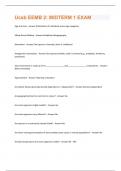
-
Ucsb EEMB 2: MIDTERM 1 EXAM QUESTIONS & ANSWERS RATED 100% CORRECT!!
- Exam (elaborations) • 19 pages • 2024
- Available in package deal
-
- $7.99
- + learn more
Age structure - Answer-Distribution of individuals across age categories Alfred Russel Wallace - Answer-Established biogeography Amenalism - Answer-One species is harmed, other is unaffected Antagonistic interactions - Answer-One species benefits, other is harmed (e.g., predation, herbivory, parasitism) Any environment is made up of its ________________ and ________________ components. - AnswerBiotic and abiotic Aposematism - Answer-'Warning' coloration Are abiotic factors generally den...
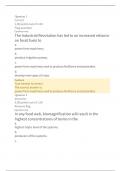
-
ENVS 1126 Test 3 (Louisiana state university)
- Exam (elaborations) • 37 pages • 2023
-
- $19.49
- + learn more
Question 1 Correct 1.00 points out of 1.00 Flag question Question text The Industrial Revolution has led to an increased reliance on fossil fuels to a. power farm machinery. b. produce irrigation pumps. c. power farm machinery and to produce fertilizers and pesticides. d. develop new types of crops. Feedback Your answer is correct. The correct answer is: power farm machinery and to produce fertilizers and pesticides. Question 2 Incorrect 0.00 points out of 1.00 Remove flag ...
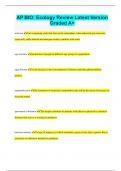
-
AP BIO: Ecology Review Latest Version Graded A+
- Exam (elaborations) • 15 pages • 2024
- Available in package deal
-
- $9.99
- + learn more
AP BIO: Ecology Review Latest Version Graded A+ acid rain rain containing acids that form in the atmosphere when industrial gas emissions (especially sulfur dioxide and nitrogen oxides) combine with water age structure proportion of people in different age groups in a population algal blooms a vast increase in the concentration of diatoms and other photosynthetic protists. ammonification the formation of ammonia compounds in the soil by the action of bacteria on decaying matter...
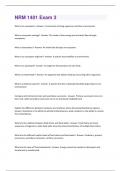
-
NRM 1401 Exam 3 Questions With All Correct Answers!!
- Exam (elaborations) • 6 pages • 2024
- Available in package deal
-
- $7.99
- + learn more
What is an ecosystem? -Answer- A community of living organisms and their environment. What is ecosystem ecology? -Answer- The study of how energy and nutrients flow through ecosystems. What is disturbance? -Answer- An event that disrupts an ecosystem. What is an ecosystem engineer? -Answer- A species that modifies its environment. What is an autotroph? -Answer- An organism that produces its own food. What is a heterotroph? -Answer- An organism that obtains food by consuming other organisms...
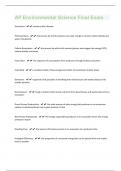
-
AP Environmental Science Final Exam | 200 Questions and Answers(A+ Solution guide)
- Exam (elaborations) • 17 pages • 2023
- Available in package deal
-
- $12.49
- + learn more
Succession - -recovery after disaster Photosynthesis - -the process by which producers use solar energy to convert carbon dioxide and water into glucose Cellular Respiration - -the process by which cells convert glucose and oxygen into energy (ATP), carbon dioxide, and water Food Chain - -the sequence of consumption from producers through tertiary consumers Food Web - -a complex model of how energy and matter move between trophic levels Detrivores - -organisms that specialize in breaking ...

-
IB ESS Topic 2 || All Questions Answered Correctly.
- Exam (elaborations) • 6 pages • 2024
- Available in package deal
-
- $10.32
- + learn more
Biotic factors correct answers the living organisms in an ecosystem abiotic factors correct answers the non-living factors in an ecosystem trophic level correct answers the position an organism occupies in a food chain as a result of its feeding habits food chain correct answers a simple linear relationship which shows how energy is transferred between organisms as each consumes an organism from a lower trophic level food web correct answers a group of interconnected food chains b...
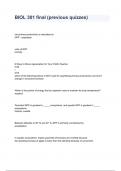
-
BIOL 301 final (previous quizzes) with Solutions
- Exam (elaborations) • 14 pages • 2023
- Available in package deal
-
- $11.49
- + learn more
BIOL 301 final (previous quizzes) with Solutions net primary productivity is calculated as GPP - respiration units of GPP kJ/m2/y 6 Ways to Show Appreciation for Your Child's Teacher 0:29 / 0:54 which of the following factors is NOT used for quantifying primary productivity over time? change in consumer biomass Which is the portion of energy that an organism uses to maintain its body temperature? respired Terrestrial NPP is greatest in _____ ecosystems, and ...

That summary you just bought made someone very happy. Also get paid weekly? Sell your study resources on Stuvia! Discover all about earning on Stuvia


